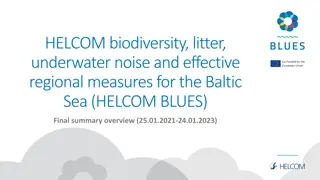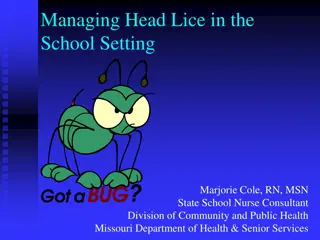
Effects of Sea Lice on Salmon Populations in New Brunswick
Learn about the negative impact of sea lice on salmon populations in New Brunswick, including how these small parasites can harm both wild and farmed fish, causing fin damage, skin erosion, bleeding, and stress that can lead to death. Discover efforts to mitigate this threat, such as the use of green technology for sea lice treatments in the aquaculture industry.
Download Presentation

Please find below an Image/Link to download the presentation.
The content on the website is provided AS IS for your information and personal use only. It may not be sold, licensed, or shared on other websites without obtaining consent from the author. If you encounter any issues during the download, it is possible that the publisher has removed the file from their server.
You are allowed to download the files provided on this website for personal or commercial use, subject to the condition that they are used lawfully. All files are the property of their respective owners.
The content on the website is provided AS IS for your information and personal use only. It may not be sold, licensed, or shared on other websites without obtaining consent from the author.
E N D
Presentation Transcript
In New Brunswick we are very famous for our Salmon and a couple things that have been harming our famous friends are Sea lice and Rock snot. We are here to help explain the negative effects of these threats. https://encrypted-tbn1.gstatic.com/images?q=tbn:ANd9GcSE3LGuLGEgTxhEK8ZWZ9vdexk63WFClZ4kh3r9rdnxVFUliEYHmjPjAA https://encrypted-tbn1.gstatic.com/images?q=tbn:ANd9GcRgKOJRglUMQjZ43dsBnFZKzCK-dr3GVJv6Ph2sE9hMFeY6mpQKdvAgsA
What are sea lice? Sea lice are small naturally occurring marine parasites that reside on the bodies of both wild and farmed fish; they attach themselves to the skin, fins, and gills of fish and feed on mucus and skin The sea lice are benefiting from feeding on the fish but, the fish aren t because there are always negative side effects to having a sea lice on the fish. Nauplius 1&2 Copepodid Adult female Adult male Chalimus 1 Pre adult 1&2 Chalimus 2
Facts about Sea lice They grow depending on water temperature survive up to 191 days, producing as many as 11 pairs of egg strings 13 known species of sea lice a couple of lice on a juvenile salmon, can hurt them severely or kill them When the infest salmon farms they will come back every year knowing there will be a food source there to feed on
Is it hurting salmon populations? they will come back every year knowing there will be a food source there to feed on can cause serious fin damage, skin erosion, constant bleeding, and deep open wounds creating a pathway for other pathogens Fish affected with lice can get extremely stressed, and this stress can even kill the fish. carry diseases between farmed and wild salmon spill over spillback.
continued The ACFFA industry has invested over $2 million dollars in a collaborative pilot project to lease and investigate the use of boats for the delivery of sea lice bath treatments a green technology that reduces the amount of product required for treatments for the sea lice by 65 per cent. Many are exposed to sea lice during their journey because fish farms are typically located in sheltered waters along wild salmon migration routes Male sea lice are known to take the risk to find a different food source. https://encrypted-tbn2.gstatic.com/images?q=tbn:ANd9GcRP3nRze9x48VLHYbOlGJ7dLVIAS0b7-YlcWzsF4fnwKT55wRSIb9FuRpSC https://encrypted-tbn3.gstatic.com/images?q=tbn:ANd9GcShLQ0QXQ8hvRyqT_XMWNkzC4zteHPv1xbe89FLjvmMC86fsHwIOKHbd5A
Conclusion In conclusion sea lice can be dangerous and there is a lot of negative effects as to positive affects because there really are no positive affects to sea lice. I believe that it is a big problem in salmon farming and more reasearch should be put into a better solution for the farms.
Rock Snot Didymosphenia geminata Sarah and Chase
Didymo can have dangerous effects on our water systems, what scientists are trying to do is figure out the actual cause for these blooms and find a solution
(Didymosphenia). (algae) Algae: distinguished from plants by the absence of true roots, stems and, leaves (algae) Didymo Reproduces sexually and asexually. Asexually can cause stalk build up outside the cell. It is a diatom
Background Information Thought to have originated in North America, Europe and Asia In 2006, didymo made an appearance in Quebec and New Brunswick It was also the first time Atlantic salmon in North America became harmed by it Matapedia River in Quebec In New Brunswick didymo spotted in the Kedgwick, Patapedia, Upsalquitch, Matapedia and below the Matapedia which come together to make up the Restigouche drainage. Shikatehawk Stream o o o o o o (Didymosphenia) (Bothwell, Spaulding) (Didymo. New Brunswick)
Cause of the blooms? Scientists believed it came from another area, but didymo sediments have been found dating back to 1896, 1910 and 1970. Two studies were done with the hypothesis of global warming as the cause of the blooms. Michelle Larvey s study Michelle Larvey s study Taylor s study Taylor s study Researchers analyzed the algae sediments from the bottom of a lake. They were wondering how populations of different algae fluctuate with time. They found a common trend when temperatures increase and what effects algae had on the lake. Earlier springs cause the snow to melt and ground to thaw earlier than normal. That means even more nutrients from the ground are used up by microbes to survive and less nutrients are making their way into the water because of it. (Moore). ( Rock Snot ).
Phosphorus/nutrient rich water vs. nutrient poor water Didymo (Invasive Species: Didymo) (What).
(Rock Snot) (Didymo (Rock Snot)). (Moore). The Dangers (Invasive plants). Clogged Gills Blocks out sun s energy Whirling disease Bugs Decreases oxygen (when it decomposes) https://encrypted-tbn0.gstatic.com/images?q=tbn:ANd9GcRGFvQcF4o89mY5iPcZFvTt0loEzflkea1yhHitpVGNuBbzkL-2yHLOU7eQ Moves fish away from natural spawning range
(Rock Snot). (Didymo/Didymosphenia). (Invasive plants). How to Clean Equipment Didymo can survive up to 40 simply rub off with a cloth .To ensure the didymo is diminished on the cellular level, scientists recommend that your equipment is cleaned with dish detergent or a household bleach then washing it through roughly in very hot water, of about 60 will also wipe out live didymo cells when the moisture from your boots or waders freezes 40 days out of the water; it does not 60 C C. Extremely cold conditions File:Didymo signage on Waiau river.jpg
(Didymo/Didymosphenia). Didymo is not lethal to humans and does not affect us the same way it does aquatic life but it can take a toll on our economy. Hydropower, recreational and occupational fishing and tourism are all affected when didymo blooms It also makes it impractical for swimming in the river in the summer time and to do any other water related activities.
Positions Chase - Research on didymo and didymo extermination protocols should continue. Sarah If global warming is the cause, we should do more things to protect our environment.
Summary oIt is a single-celled algae oHas been spotted in New Brunswick in the Restigouche and Upper Saint John River o Global warming suspected to be the cause oPoses a risk to fish, aquatic plants oGood conditions for whirling disease o Clean equipment with very hot water or very cold temperatures oTakes a toll on the economy TAKE CARE OF THE ENVIRONMENT!
OXYGEN DIATOM Chlorophyll economy economy Clog Clog Didymosphenia geminata Bleach Stalk Stalk equipment Asia






















